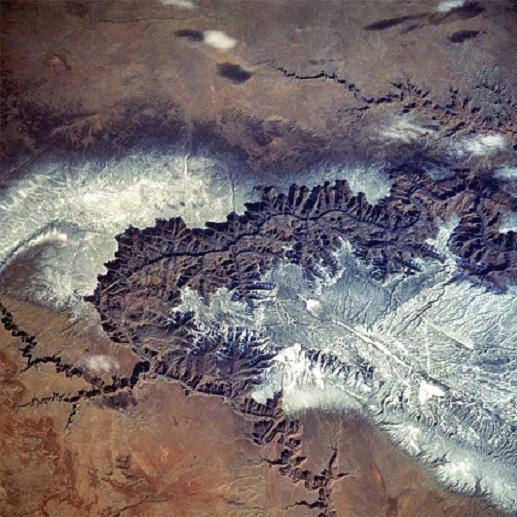
home •
about •
essential guide •
picture of the day •
thunderblogs •
news •
multimedia •
predictions •
products •
get involved •
contact
picture of the day archive subject index
The Grand Canyon from space. Credit: Rick Searfoss, retired Space Shuttle commander
Sep 29, 2008
The Grand Canyon: Part One
The Grand Canyon is approximately 400 kilometers long, 28 kilometers wide, and almost two kilometers deep. Could erosion by the Colorado River be the only factor in its formation?The face of the earth presents many problems for geologists, not the least of which is that the Grand Canyon is supposed to have been formed by the Colorado River. As recently as six years ago geologists were working with four different and mutually exclusive models of the canyon's creation. At a special meeting they managed to winnow the four theories down to two—neither one of them satisfactory—with more than one reason to refute them both. One geologist noted that the only way the Colorado River could have carved the canyon is if it came out of the sky.
A few basic facts are necessary to gain a perspective. The Grand Canyon is surrounded by an elevated landscape with the canyon running through it from east to west. The underlying rock strata in the region rises and falls over an area known as the Kaibab Upwarp, while the river descends through an elevation differential of 2100 meters. Water does not flow up over a mountain range nor does it run sideways along sloping terrain, so all theoretical models that insist on water erosion propose that the entire area was slowly uplifted at the same rate as the river eroded the canyon. This process is said to have taken place in a time span of between four million and 400 million years.
The geological models also incorporate natural dams across the river channel that caused reversals in the river flow and were then subsequently breached, allowing the river to resume its previous course. However, a pertinent objection to that theory is that there is no evidence water flowed back into the ends of the giant side channels that join the chasm with the river. Perhaps the most significant challenge to the prevailing theories is the disappearance of almost 1300 cubic kilometers of material that is supposed to have been washed downstream—there is no large delta at the mouth of the Colorado River containing the debris.
Satellite images, as well as pictures taken by astronauts in orbit, seem to indicate that the Grand Canyon is an enormous Lichtenberg figure, in other words, a gigantic lightning scar. As the Electric Universe hypothesis suggests, electric discharge machining (EDM) might account for the Canyon's appearance: steep walls, thousands of layers, brachiated side canyons at practically every scale, and periodic, hemispherical "nips" cut into each rim.
Geologists possess few tools that can help them understand planetary scars caused by EDM because there are no courses in electricity needed to obtain a degree. But electrical engineers and plasma physicists are taught that charged objects immersed in electric fields develop protective sheaths known as Langmuir sheaths, named after plasma pioneer Irving Langmuir. The sheaths isolate the charged objects (or plasma clouds) from one another in envelopes made up of double layers. If the charged objects are planets, then they are normally surrounded by tear-drop-shaped, double layer plasmaspheres.
It is known from laboratory experiments that if two charge sheaths touch one another there is an exchange of electrical potential until they reach equilibrium. If the current flow is large enough, there will be a visible arc and a flash, otherwise known as a lightning bolt. The planetary scarring hypothesis interprets the laboratory experiments using a scaled-up approach. If the smaller charge sheaths interact in a certain way, then the larger planetary plasmaspheres will act in similar fashion, releasing gigantic lightning bolts.
Discharges of such magnitude are capable of stripping rock and gas from a planet with far greater energy than the comparatively puny force of gravity. Since the rim edges of the Grand Canyon are sharp and do not show much erosion, then an argument could be made for a recent formation. It is therefore possible that the Grand Canyon, as well as the entire Southwestern region was recently etched with EDM forces on a colossal scale in an encounter with another planetary body. The surface biota, soil and rock, and most of the water was obliterated.
A Birkeland current in contact with the Earth might act like a rotating augur, drilling deeply into the bedrock, removing the material, and accelerating it up and away from the point of contact. The effect might be thought of as an electric vacuum, charging the debris in an expanding electric field and then blasting it upward through the power of like-charge repulsion. EDM effects in machine shops strip uniform layers from the substrate while leaving essentially a vertical wall and a flat, new surface. In an interplanetary EDM, the rotating current would tend to lift up sections of strata that would leave a terraced effect and layered appearance, much like what is seen in the Grand Canyon.
Contributed by Michael Armstrong
___________________________________________________________________________Please visit our Forum
The Electric Sky and The Electric Universe available now!

|
|

|
EXECUTIVE EDITORS:
David Talbott, Wallace Thornhill
MANAGING EDITORS:
Steve Smith, Mel Acheson
CONTRIBUTING EDITORS: Michael Armstrong, Dwardu Cardona,
Ev Cochrane,
C.J. Ransom, Don Scott, Rens van der Sluijs, Ian Tresman
WEBMASTER: Brian Talbott
Copyright 2007: thunderbolts.info
![]()
home •
thunderblogs •
forum •
picture of the day •
resources •
team •
updates •
contact us

